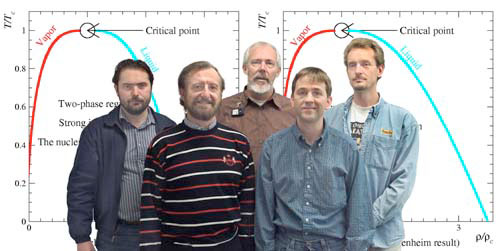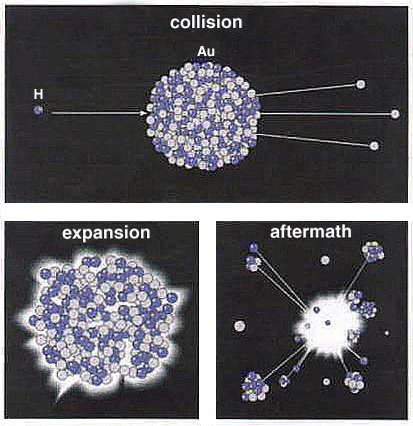|
|
 |
Scientists at Lawrence Berkeley National Laboratory believe they have
solved a mystery concerning atomic nuclei that's persisted for several
decades. Taking a new approach to the analysis of existing experimental
data, the researchers found the strongest evidence to date that atomic
nuclei can be made to undergo a "phase transition" and change
from a liquid to a vapor state.
"The question has been whether the nucleus can be treated as a liquid
drop, for which we can generate a phase diagram showing its transition
from a liquid to a vapor," says Luciano Moretto, a chemist and coleader
of this study. "We've shown the answer to this question is yes."
 |
|
| The team that uncovered nuclear phase
changes: (from left, front) Luciano Moretto and Larry Phair, (back)
Dimitry Breus, Gordon Wozniak, and Jim Elliott |
The findings of the study were reported in the January 14, 2002, issue
of Physical Review Letters. In addition to Moretto, Berkeley Lab
authors were Gordon Wozniak, the study's coleader, and James Elliott and
Larry Phair, all with the Nuclear Science Division. Nine authors were
also cited from the ISiS Collaboration led by Vic Viola of Indiana University.
Understanding the nature of matter requires knowing the boundary between
its different phases, and how it changes from one phase to another. For
example, imagine trying to understand the nature of water without knowing
that under the right conditions it can be transformed into ice or steam.
To understand the nature of atomic nuclei, scientists have long treated
the nuclei as tiny drops of liquid, for which the physical properties
and behaviors have been well-characterized.
If this "liquid drop model" is accurate, scientists believed
that under the right conditions — such as in the fireballs of particle
accelerator collisions — the protons and neutrons inside an atomic
nucleus should behave like ordinary molecules, and the nuclei should change
from liquid to vapor phases. However, until now no one has been able to
demonstrate that such a transition occurs.
| |
 |
|
|
 |
Schematic diagram of the collision stages in reactions
between a 5 GeV hydrogen ion and a gold nucleus: in the initial stage,
heat is deposited in the nucleus, accompanied by the knockout of several
fast particles. The hot nucleus then thermalizes and expands, eventually
undergoing a "soft explosion," or multifragmentation. During
this process, the nucleus acts like a molecule that is going from
the liquid to the vapor state. (Image courtsey of Vic Viola, University
of Indiana.
|
"One problem is that the nuclear matter inside atomic nuclei consists
of only scores of neutrons and protons compared to the 10-to-the-24th
molecules in a glass of ordinary liquid," says Wozniak. "Furthermore,
in order to observe nuclei change from liquid to vapor, temperatures of
nearly one hundred billion degrees Celsius are required. No container
is available, and the vaporization must occur in vacuum."
The Berkeley Lab scientists succeeded where others before them had not,
by departing the beaten nuclear science path of identifying critical components,
caloric curves, and negative heat capacities.
"We borrowed from the materials scientists and treated the multiple
fragments of nuclei emerging from relativistic heavy ion collisions as
aggregates or clusters of molecules," says Phair.
Treating the fragments of nuclei as clusters of matter brings into play
mesoscopic (intermediate scale) physics, sufficiently well understood
to generate a nuclear liquid-to-vapor phase diagram. When the Berkeley
Lab researchers did this, they produced a curve that matched the predictions
of theoretical models.
"It was the signature we were looking for," Phair says, "a
curve that describes the process by which excited nuclei undergo a liquid-to-vapor
phase transition."
The Berkeley researchers worked with data from two major experiments,
the ISiS (Indiana Silicon Sphere) collaboration experiments of 1997, and
the EOS (Equation of State) collaboration experiments of 1990-1992. The
ISiS experiments involved the multifragmentation of gold nuclei, and the
EOS studies involved multifragmentation of gold, lanthanum, and krypton.
"Recent experiments have made advances towards proving that nuclei
undergo a liquid-to-vapor phase transition, but these efforts suffered
from incomplete knowledge of the location of the nuclear fluid in density/pressure
space," says Moretto. "By taking a cluster approach to the data,
measurements of the nuclear fluid's location in density/pressure space
could be made. More importantly, a phase diagram of finite-charge nuclear
matter could be mapped."
Says Elliott, "We analyzed both the ISiS and EOS data sets in order
to survey an experimentally based Mason-Dixon line between nuclear liquid
and gas on a pressure-versus-temperature plot. This represents the first
experimental measurement of any phase diagram not bound together by electromagnetic
forces."
With their phase diagram, the Berkeley Lab researchers say that, given
the size of the fragmented nuclei and the energy that was used to fragment
them, they can predict the temperatures and pressures under which the
nuclei will change from the liquid to the vapor phase.
As with materials scientists, the next step for nuclear scientists will
be to determine how the properties of atomic nuclei clusters compare to
the properties of bulk nuclear matter.
Says Elliott, "The resemblance of the alien form of nuclear matter
we mapped in our phase diagram to the ubiquitous bulk nuclear matter supported
by electromagnetic forces is highly significant. It could mean that the
behavior of matter is determined by its form rather than by the origin
of the force that holds it together."
Additional information:
|

